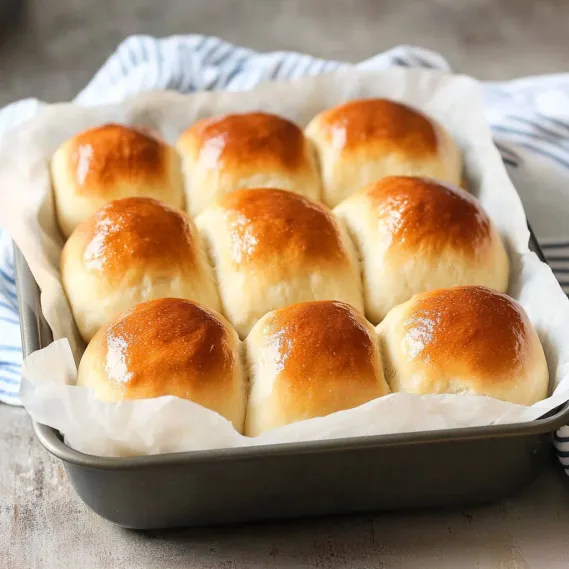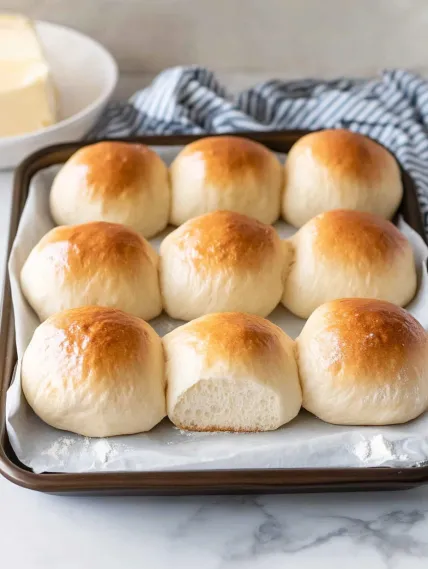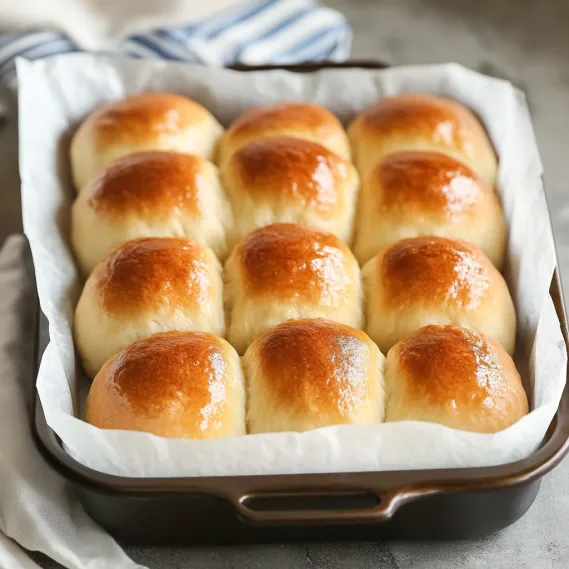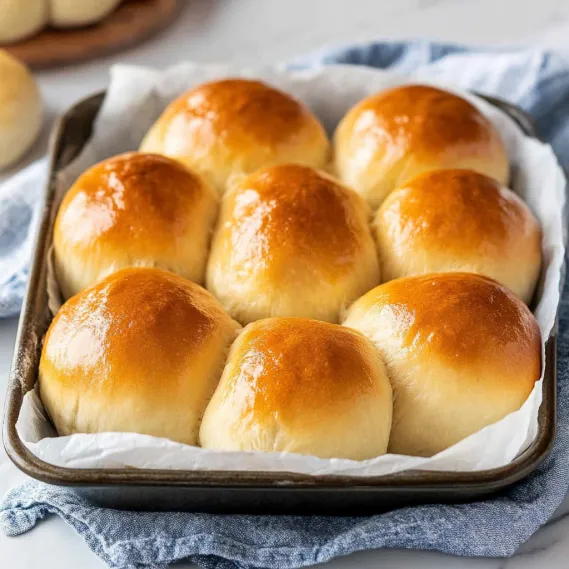 Pin it
Pin it
These pillowy mix-and-wait dinner rolls will make you forget all about complicated bread recipes. Just dump ingredients in a bowl, stir them together, and let time work its magic—no kneading, no special equipment, just a bit of patience. They turn out with a beautiful golden crust, cloud-like interior, and that irresistible balance of subtle sweetness and salt. Serve them warm with a pat of butter at your evening meal or use them for sandwiches the next day—they're a total game-changer for anyone who wants homemade bread without the hassle.
I whipped these up for our weekly family dinner, and they disappeared faster than the main course. My husband usually only cares about crusty artisan bread, but he couldn't stop talking about how airy these were. Now they're on regular rotation—sometimes I make them just to fill the house with that incredible fresh bread aroma.
Essential Components
- Bread Flour: Creates that cloud-like texture—regular flour works too, but bread flour delivers the fluffiest results. Get a new bag if yours has been sitting around; stale flour affects the taste.
- Dry Yeast: The magic behind the rise—check that it bubbles properly before starting. I grab instant yeast from my grocery store and it's always reliable.
- Milk: Slightly warm whole milk adds depth—you can use low-fat but the rolls won't be quite as tender. Just warm it until it feels comfortable on your wrist, not hot.
- Butter: Melted then cooled brings richness and keeps everything soft. Using unsalted lets you control the final flavor.
- Eggs: Let them come to room temperature for smooth mixing and better rising—cold eggs can slow everything down.
The butter really makes these rolls stand out—giving them that special something without any extra work. I tried making them without it once, and they just weren't as impressive. My family can literally smell the difference—they come running when that buttery scent fills the kitchen.
Simple Steps to Fluffy Success
- Step 1: Activate Your Yeast
- Combine 1 tablespoon dry yeast with 2 teaspoons of your sugar (from the total ¼ cup) and ½ cup warm water in a small cup. Wait 5 minutes until it's bubbly—if nothing happens, your yeast is dead and you'll need a fresh package.
- Step 2: Form Your Batter
- In a large bowl, mix 4 cups bread flour with the remaining sugar and 1 ½ teaspoons kosher salt. Create a hole in the middle, then pour in 1 cup barely warm milk, 3 ½ tablespoons melted butter, 2 beaten eggs, and your foamy yeast mixture. Stir everything with a wooden spoon until you get a chunky, sticky mass—it should be thicker than cake batter but not firm dough.
- Step 3: First Rest Period
- Cover the bowl with a moist tea towel and place it somewhere warm (at least 77°F) for 1 ½ to 2 hours until it's almost tripled in size with bubbles on top. My secret spot? I run the clothes dryer for a minute empty, then put the bowl inside—works perfectly every time.
- Step 4: Form Your Rolls
- Put parchment paper in a 9x13-inch baking dish with edges hanging over. Press the dough down to release large air bubbles, then dump it onto a floured surface. Dust the top lightly, shape into a rectangle, and cut into 12 equal chunks. For each piece, press it flat, pull sides upward like you're making a little sack, flip it over, and roll gently to create a smooth ball—this keeps the tops looking perfect. Arrange them in the pan in 4 rows of 3.
- Step 5: Second Rest Period
- Spray the rolls with cooking oil (or cover with oiled plastic wrap) and let them sit in that warm spot for 30-45 minutes until they've grown about 75% bigger—not fully doubled. Start preheating your oven to 350°F (fan) or 390°F (standard) halfway through this wait.
- Step 6: Cook and Finish
- Bake for 15-18 minutes until they're golden on top—tap the center roll and listen for a hollow sound. Brush with 1 tablespoon melted butter immediately after taking them out, then transfer to a cooling rack for a few minutes before serving them warm.
 Pin it
Pin it
The way the yeast works in this recipe amazes me every time. My mom tried a batch and said they reminded her of her grandmother's rolls, except without all the hard work. We've been fans ever since, especially when they're slathered with butter straight from the oven.
Plan Ahead Options
These rolls fit perfectly into busy schedules. Just shape them, stick them in the refrigerator overnight (tightly covered), and let them sit at room temperature for 30 minutes before baking. I've done this for holiday meals—everyone gets fresh rolls without any morning stress.
 Pin it
Pin it
Fun Flavor Variations
Try brushing them with garlic butter after baking for something savory—my children can't get enough. Or mix some cinnamon sugar into the dough for a breakfast treat. I once added shredded cheddar to the mix—those cheesy golden rolls vanished within minutes.
Keeping Them Fresh
Rolls tend to dry out after a day, but 15 seconds in the microwave brings back their softness. You can freeze them either fully baked or as shaped dough—just thaw in the fridge overnight, then warm at 320°F covered with foil for 8 minutes. I always keep some frozen for quick meal additions.
Ways to Enjoy Them
They pair wonderfully with a hot bowl of soup—the soft centers soak up broth beautifully. During Thanksgiving, I've cut them in half for tiny turkey sandwiches—everyone loved them. They even make breakfast special with just a spoonful of jam.
 Pin it
Pin it
These pillowy mix-and-wait dinner rolls show how kitchen magic can be straightforward, forgiving, and incredibly tasty. They prove you don't need to struggle with dough to enjoy homemade bread. Just one bite will get you hooked on both their simplicity and amazing flavor.
Frequently Asked Questions
- → Why isn't kneading needed for this dough?
- Because the dough is extra wet, the gluten forms over time as it sits. This means the yeast has plenty of space to work its magic and create air bubbles for soft, airy rolls. Patience replaces the physical effort of kneading.
- → Can I swap instant yeast with active dry yeast?
- Sure can! Active dry yeast works too since you dissolve it first in liquid. Follow the same amounts and steps in the recipe—proofing in warm water with sugar activates either type.
- → What can I do if my house is cold for rising dough?
- Try this: 1) Warm up your oven briefly, turn it off, and let the dough rise inside. 2) Dryers work too—run it for a couple of minutes, then place the bowl in. 3) A microwave with a cup of hot water can act as a cozy spot.
- → Is it possible to prep these rolls in advance?
- Yep! Shape the rolls after the first rise, then cover and refrigerate for 4-24 hours. Let them sit out about half an hour before baking to warm up. You can also bake and cool them completely, then freeze airtight for up to a month. Warm in foil or the microwave to refresh.
- → Why is my dough so sticky?
- Sticky's normal here—it makes the rolls soft. Flour your hands and surface generously, but don't add it into the dough itself. Especially in humidity, you'll need extra. When shaping, handle it gently and flip the dough quickly to avoid sticking.
- → Can I use this dough to make other shapes or filled bread?
- For sure! Create knots, small loaves, or even cloverleaf rolls in a muffin tin. If you're adding filling, flatten each piece, add your filling inside, seal it up tightly, and place on your tray seam side down. Just go easy on this soft dough to avoid tearing.
